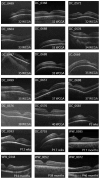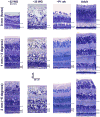Evaluation of normal human foveal development using optical coherence tomography and histologic examination
- PMID: 23044942
- PMCID: PMC3724218
- DOI: 10.1001/archophthalmol.2012.2270
Evaluation of normal human foveal development using optical coherence tomography and histologic examination
Abstract
Objective: To assess outer retinal layer maturation during late gestation and early postnatal life using optical coherence tomography and histologic examination.
Methods: Thirty-nine participants 30 weeks' postmenstrual age or older were imaged using a handheld optical coherence tomography system, for a total of 102 imaging sessions. Foveal images from 16 participants (21 imaging sessions) were normal and evaluated for inner retinal excavation and the presence of outer retinal reflective bands. Reflectivity profiles of central, parafoveal, and parafoveal retina were extracted and were compared with age-matched histologic sections.
Results: The foveal pit morphologic structure in infants was generally distinguishable from that in adults. Reflectivity profiles showed a single hyperreflective band at the fovea in all the infants younger than 42 weeks' postmenstrual age. Multiple bands were distinguishable in the outer retina at the peri fovea by 32 weeks' postmenstrual age and at the fovea by 3 months' postterm. By 17 months' postnatal, the characteristic appearance of 4 hyperreflective bands was evident across the foveal region. These features are consistent with previous results from histologic examinations. A "temporal divot" was present in some infants, and the foveal pit morphologic structure and the extent of inner retinal excavation were variable.
Conclusions: Handheld optical coherence tomography is a viable technique for evaluating neonatal retinas. In premature infants who do not develop retinopathy of prematurity, the foveal region seems to follow a developmental time course similar to that associated with in utero maturation.
Clinical relevance: As pediatric optical coherence tomography becomes more common, a better understanding of normal foveal and macular development is needed. Longitudinal imaging offers the opportunity to track postnatal foveal development among preterm infants in whom poor visual outcomes are anticipated or to follow up treatment outcomes in this population.
Figures






References
-
- Yuodelis C, Hendrickson A. A qualitative and quantitative analysis of the human fovea during development. Vision Research. 1986;26(6):847–855. - PubMed
-
- Hendrickson AE, Yuodelis C. The morphological development of the human fovea. Ophthalmology. 1984;91(6):603–612. - PubMed
-
- Diaz-Araya C, Provis JM. Evidence of photoreceptor migration during early foveal development: a quantitative analysis of human fetal retinae. Visual Neuroscience. 1992;8(6):505–514. - PubMed
-
- Mann I. The Development of the Human Retina. New York: Grune & Stratton; 1950.
-
- Yamada E. Some structural features of the fovea centralis in the human retina. Archives of Ophthalmology. 1969;82:151–159. - PubMed
Publication types
MeSH terms
Grants and funding
LinkOut - more resources
Full Text Sources
Research Materials

